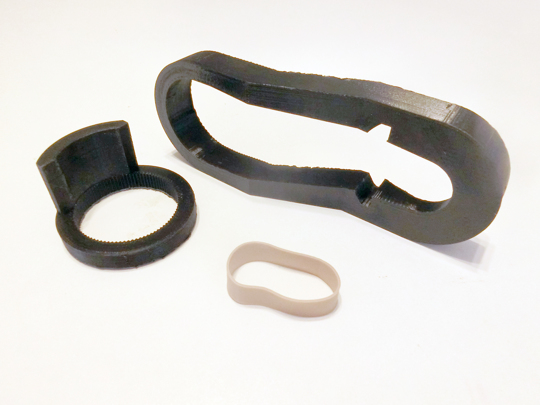If you're using your browser's reader mode, refresh the page while in reader mode to load all content.
3D-printable kit that turns doorknobs into door levers without tools
doorknobs are terrible
Ever try to use a doorknob with your elbow? It’s difficult!
Door levers are more accessible than doorknobs for pretty much everyone. A simple fix is to install door levers in place of doorknobs. But what if you don’t have the tools to install a door lever? Or what if you don’t have the permission, such as at your workplace?
prototyping a solution
3D printing was the most viable way for me to create a functioning prototype. However, due to the cost and timesink of 3D printing, it wasn’t appropriate to immediately churn out large plastic pieces. I used paper to figure out how the components might fit on the doorknob and around each other before sketching out forms in Rhino. I also 3D printed small studies that isolated one aspect of the kit, like notch sizes.
initial sketches

goal
Get some ideas out of my head.
action
Freely sketched ideas of components on paper.
result
A collection of ideas about how components could be shaped, how they might fit together, and how they would attach to the doorknob.
paper models

goal
Find out how components would fit on doorknob and one another.
action
Cut and taped paper approximations of components. Attempted to install them onto a small cup representing a doorknob to see what obviously wouldn't work.
result
Figured out a shape that could both move past the thick part of the doorknob and fit snugly into the thin part.
mechanism studies

goal
Learn about quirks and nuances of 3D printed parts that are meant to attach to and detach from one another.
action
3D printed small proof/disproof-of-concept pieces, such as a series of notches that differed micrometers in size to see which fit the best.
result
Figured out which ways of attaching components wouldn't work. Developed some best practices for designing and printing components.
a functional prototype
After several mishaps in the printing process, I finally produced a prototype that worked. The kit consists of a lever that goes behind the doorknob, a rubber band that grips the doorknob, and a ring that couples them together. Installation takes less than a minute.
kit components

demo video
If the embedded video isn't working, try your browser's reader mode or watch on YouTube.
step 1

step 2

step 3

what next?
The kit works, but has much room for improvement:
- The lever could be more comfortable by curving sharp edges or adding surface material.
- Tweaking notch shapes would ease installation.
- Currently, it’s only compatible with a limited range of doorknobs.
- Right now you need well-functioning fingers to perform an installation, which isn’t very empowering for those without strong fingers.
- A version that travels with the user rather than staying on the door might be more convenient and resource-efficient.
aside: the role of guerilla public service in transition design

<figcaption>Artist disguised as a government construction worker alters a highway sign</figcaption>
<small>From <a href="http://ankrom.org/freeway_signs.html">Catherine Cummings, Richard Ankrom</a></small>When conceptualizing the door lever kit, I realized that it had the potential to be like graffiti; anyone with appropriate equipment, enough ability, and a compatible arena could produce and install it. The kit gives people agency to alter their environment. Some might consider this guerilla public service.
Real change comes from transforming entire systems. But that takes a long time, and immediate consequences wait for no one. In the interim, bandages like the door lever kit can provide temporary relief in lieu of complete repair.
Some might be inclined to metaphorically (or literally) take a sledgehammer to barriers. Such an act may incite conflict rather than conversation, which is required for peaceful acceleration of progress. The nondestructive nature of the door lever kit supports peaceful progress.
There’s a lot more for us to discover about guerilla public service. I hope it turns out to be a great complement to systemic change.